Originally posted at: http://www.nerdfitness.com/
I get an email at least once a day that says the following:
“Steve, what should I do for a workout?”
After all, many people are interested in getting started with strength training and want to know what workout routine to follow.
Considering that a program should be developed around a person’s biology, age, goals, diet, free time, etc, there’s a lot of factors I can’t get in through email that would allow me to tailor a program specific to that person.
It’s really easy to overcomplicate this process as there are an infinite number of exercises, sets, reps, and programs to choose from.
And yes, we have a solution for people that JUST want to be told what exactly to do: Our uber popular 1-on-1 coaching program pairs you with your own Nerd Fitness Coach who will get to know you, your goals, and your lifestyle, and develop a workout plan that’s specific to not only your body, but also to your schedule and life.
We take the guesswork and uncertainty out of this process for hundreds of people – and we’d love to be able to pair you with a coach who can do the same: click the image below and speak with our team to learn more:
*****
Now, if you’re more of a “get my hands dirty and figure this stuff out on my own,” kind of person, – we’re going to dig into how to build your own workout plan today!
Developing a workout routine for yourself can be intimidating, but it’s really not too difficult and kind of fun once you understand the basics.
If you are ready to start building your own routine and want to know how its done, great, let’s do this!
You can download our free guide, Strength Training 101: Everything You Need to Know, which will help you build a workout with bodyweight exercises all the way up through your first few weeks in a gym with weight training.
Grab the guide free when you sign up in the box below and join the Rebellion!
- Everything you need to know about getting strong.
- Workout routines for bodyweight AND weight training.
- How to find the right gym and train properly in one.
Woman
Man
Determine Your Situation

For starters: how much time can you devote to exercise?
If you can do an hour a day, that’s awesome.
If you have a wife or husband, three kids, a dog, two jobs, and no robot butler, then maybe you only have thirty minutes, twice a week.
That’s fine too.
Whatever your time commitment is, developing the most efficient workout is crucial. Why spend two hours in a gym when you can get just as much accomplished in 30 minutes, right?
After all, we know that weight training is the fat-burning prize fight victor, and efficiency rules all.
Next, you’ll want to determine WHERE you’ll work out:
- At a gym? Here’s how to behave in a commercial gym.
- At home? Have you tried our beginner bodyweight workout?
- In a park? Try our park workout.
Once you determine where you want to train, and how much time you have, we can start to use the equipment you have to build your routine and more.
What Exercises Should I Do?
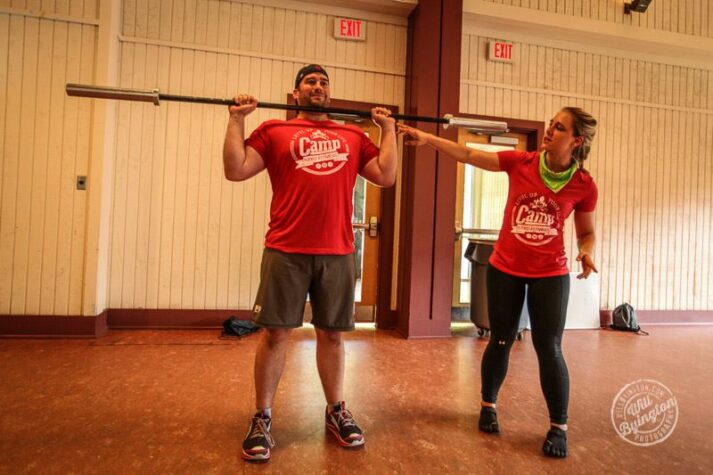
I like to follow the motto of “Keep it simple, stupid.”
(Note: I am not calling you stupid. You’re reading Nerd Fitness, which means you’re intelligent, good looking, really funny, but most of all, modest.)
The best workout is the one that you actually stick with, and people make things FAR too complicated and try to target a bazillion different individual muscles with six types of exercises for each body part.
It’s exhausting, unnecessary, inefficient, and intimidating.
So keep it simple! We’re going to pick 5 exercises, and get really strong with those movements.
This is the ENTIRE philosophy behind our Strength 101 series.
Unless you’ve been strength training for years and know what you’re doing, we recommend that you pick a full body routine that you can do 2-3 times a week.
You want a routine that has at least one exercise for your:
- Quads (front of your legs).
- Butt and hamstrings (back of your legs).
- Chest, shoulders, and triceps: (“push” muscles).
- Back, biceps, and grip ( “pull” muscles).
- Core (abdominals and lower back).
Yup, by targeting compound movements that recruit multiple muscles at the same time, you can build a full body routine that uses only four or five exercises.
Hows THAT for efficiency!
Here is a quick breakdown on those movements:
- Quads – squats, lunges, one legged squats, box jumps.
- Butt and Hamstrings – deadlifts, hip raises, straight leg deadlifts, good mornings, step ups.
- Push (chest, shoulders, and triceps) – overhead press, bench press, incline dumbbell press, push ups, dips.
- Pull (back, biceps, and forearms) – chin ups, pull ups, bodyweight rows, dumbbell rows.
- Core (abs and lower back) – planks, side planks, exercise ball crunches, mountain climbers, jumping knee tucks, hanging leg raises.
Pick one exercise from each category above for a workout, and you’ll work almost every single muscle in your body. Get stronger with each movement each week, and you have yourself a recipe for a great physique.
An example for a great, effective, simple workout:
- Barbell squats: 5 sets of 5 reps.
- Barbell Deadlifts: 3 sets of 3 reps.
- Push-ups: 3 sets of 15 reps.
- Pull-ups (or rows): 3 sets of 8 reps.
- Planks: 3 sets, 1 minute hold each.
Don’t need to make things more complicated than this!
If you’re not sure how to do any of the movements above, click on their links for thorough write-ups. Want high-definition multi-camera demonstrations of each exercise?
Here’s a sample video from the 100+ in our online course, the NF Academy, with Team NF’s Jim and Staci demonstrating a proper bodyweight push-up:
As stated above, when building your workout, don’t overthink things!
Pick one exercise from EACH category above, specifically ones that scare you the least, and that will be your workout every other day for the next week.
Once you get confident in those movements, feel free to add some variety.
Why? If you do the same exact routine, three days a week, for months and months, you and your muscles might get bored, and you’ll stop getting gains.
So feel free to stick with the above ‘formula,’ but change the ingredients:
- If you do bench presses on Monday, go with shoulder presses on Wednesday and dips on Friday.
- Squats on Monday? Try lunges on Wednesday and box jumps on Friday.
- Do deadlifts every Wednesday, but change up the sets and reps you pick!
Pick a different exercise to improve and your muscles will stay challenged, you’ll stay challenge, and you’ll actually DO the workout!
Then, focus on getting stronger!
Lastly, your muscles don’t get built in the gym, they actually get broken down in the gym, and then get rebuilt stronger when you’re resting.
Give your muscles 48 hours to recover between workouts, especially when training heavy.
A Monday-Wednesday-Friday workout works well to ensure enough time to recover, especially when you are just getting started.
I stuck with a Monday-Wednesday-Friday full day routine for nearly 10 years and just focused on getting stronger with each movement.
I realize all of this can be overwhelming, especially if you’re trying to learn Strength Training AND build your own workout too.
So we created a free resource that gives you some starter workouts (both bodyweight and weight training) that gives you the confidence to start today.
You can grab our Strength Training 101: Everything You Need to Know when you join the Rebellion and sign up in the box below:
- Everything you need to know about getting strong.
- Workout routines for bodyweight AND weight training.
- How to find the right gym and train properly in one.
Woman
Man
How Many Sets Should I Do?

SIMPLE ANSWER: Not including a warm-up set or two, I recommend doing between 3-5 sets per exercise.
A “set” is a series of repetitions that you complete without stopping. For example, if you drop down and do 10 push-ups right now, you just did 1 SET of 10 REPETITIONS (or REPS) of push-ups.
Got it? Cool.
Again, do not overthink this. Do not freak yourself out by worrying if you should do 4 sets or 5 sets. Pick one, record how you do with it, and get stronger the next time you do that movement.
So, try to keep your TOTAL (all exercises combined) workout number of sets for all exercises is in the 15-25 set range (5 exercises total, each with 4 “work sets” is a good start).
Remember, the most important part is to get started – you’ll learn how your body responds and you can adapt as you go.
What you DON’T need to do: multiple exercises for each body part with 10 sets.
Unless you are a bodybuilder or an advanced athlete following a specific protocol prescribed to you by a coach, you can stick with 4-5 sets for each of the 5 exercises in your workout routine and get outta the gym (or finish your home workout) sooner.
How Many Repetitions Should I Do?
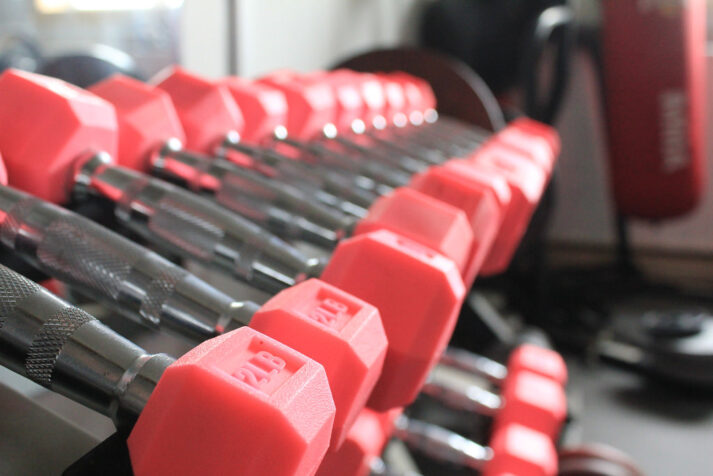
This is another thing that many people overthink.
If you are new to exercising or strength training, you’ll want to aim for higher reps per set with lighter weights as you’re learning the movements (if you’re training with weight).
As you get stronger and start to learn about how you like to train, you might switch to a lower rep range, even up to a single rep of maximum effort (on a movement like a Squat or Deadlift).
Some general rules:
If you’re looking to burn fat while building muscle, keep your number of repetitions per set in the 8-15 range per set.
If you can do more than 15 reps without much of a challenge, increase the weight or the difficulty of the movement. This is true for things like lunges, bodyweight squats, push-ups, pull-ups, etc.
There are some generally accepted ‘rules’ about how to determine how many reps you should target per set, based on your goals:
- Reps in the 1-5 range build super dense muscle and strength (called myofibrillar hypertrophy).
- Reps in the 6-12 range build a somewhat equal amounts of muscular strength and muscular size (this is called sarcoplasmic hypertrophy).
- Reps in the 12+ range build muscular endurance.
Remember that how you eat will determine if you get bigger or stronger
If you’re looking for a simple answer: do 4 sets of 8-10 reps for each movement you’ve chosen, and see how your body responds. But don’t neglect your diet! That’s 90% of the battle!
How Long Should I Wait Between Sets?

Keep it simple, you smart, good looking, funny, modest person.
Below is a basic formula for you to determine how long you should wait between sets, but this can be adjusted based on your level of health. The goal is to wait the least amount of time you need, but still rest enough that you can perform all reps of the next set safely and properly!
Here are some guidelines (not rules set in stone!):
- 1-3 Reps (lifting heavy for strength/power): Rest for 3 to 5 minutes
- 4-7 Reps (lifting for strength): Rest for 2 to 3 minutes
- 8-12 Reps (lifting for size/strength): Rest for 1 to 2 minutes
- 13 Reps+ (lifting for endurance): Rest for 1 minute or less
If you need more or less rest than the above recommendations, that’s more than okay. Do the best you can, record how long it takes you to rest between sets, and try to rest for shorter periods in the future. Your body will adjust as you get stronger and healthier!
Do NOT overthink this!
How Much Weight Should I Lift?
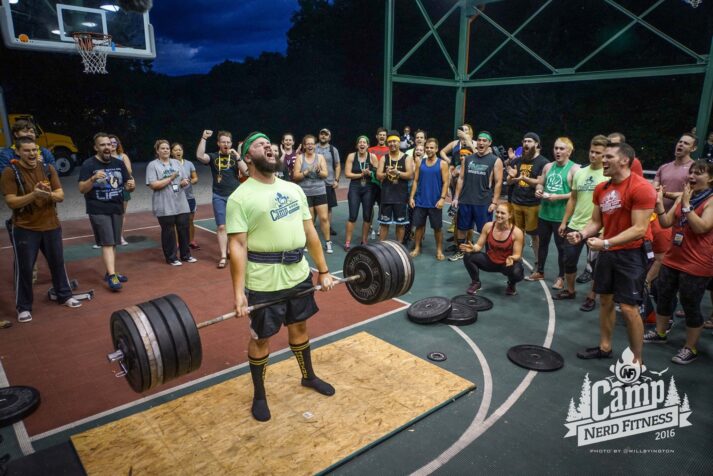
We have a FULL resource on how to determine your starting weight for lifting, but I’ll give you the gist here.
The simple to learn but tough to implement answer: lift enough so that you can get through the set, but not too much that you have NO fuel left in the tank at the end.
How do you determine how much that is?
Trial and error.
But ALWAYS err on the side of “too light” versus “too heavy” when starting out. It’s better to say “I bet I could have done more!” instead of “that was too much, and now I need to go to the hospital!”
If you’re doing exercises with just your body weight, you need to find a way to make each exercise more difficult as you get in shape – once you get past 20 reps for a particular exercise and you’re not gassed, it’s time to mix things up.
- Can you do 20 push ups no problem? It’s time to start mixing them up to be more challenging. Pick a variation from this article and make yourself work for it!
- 20 bodyweight squats too easy? Hold some weights high above your head as you do the next set. Try one-squats. Always be challenging yourself.
If you want more information on how much you should lift, and when to scale certain movements or adjust your workout, check out our Strength 101: Everything You Need to Know. It’s free when you join the Rebellion with your email in the box below:
- Everything you need to know about getting strong.
- Workout routines for bodyweight AND weight training.
- How to find the right gym and train properly in one.
Woman
Man
How Long Should I Exercise?

Easy answer: 45 minutes to an hour.
If you’re doing 15-25 sets of total exercise, you should be able to get everything done within that 45 minute block. Now, factor in a five or ten minute warm-up, and then stretching afterwards, and the workout can go a little bit longer.
If you can go for over an hour and you’re not completely worn out, you’re simply not pushing yourself hard enough.
Less time, more intensity, better results.
What if you don’t have 45 minutes? Maybe you want to build some cardio into your weight training. That’s where these next two sections come in.
Alternating Sets
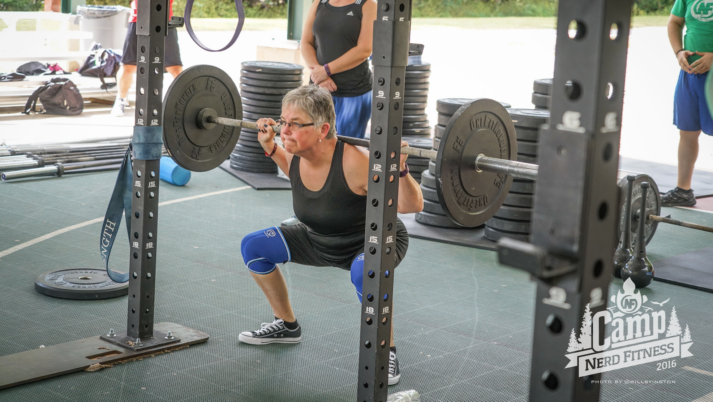
Let’s say you’re doing four sets of squats and you plan on doing four sets of dumbbell bench presses after that.
If you wait two minutes between each set, this will take you around twenty minutes or so (factoring in the time to get set and actually do the set).
Try this instead: Do a set of squats, wait one minute, then do a set of dumbbell presses, wait one minute, then do your next set of squats, and so on.
Because you’re exercising two completely different muscle groups, you can exercise one while the other is “resting.” You’re now getting the same workout done in half the time.
Also, because you’re resting less, your body has to work harder so your heart is getting a workout too. Jackpot.
Let’s see how this would play out in a sample workout:
- Lunges alternating with incline dumbbell presses, four sets each, one minute between sets.
- Wait a few minutes to catch your breath and get set for your next two exercises.
- Straight leg deadlifts alternating with wide-grip pull ups, four sets each, one minute between sets.
- 3 Sets of planks, stretch, and get the hell out of there!
Circuits
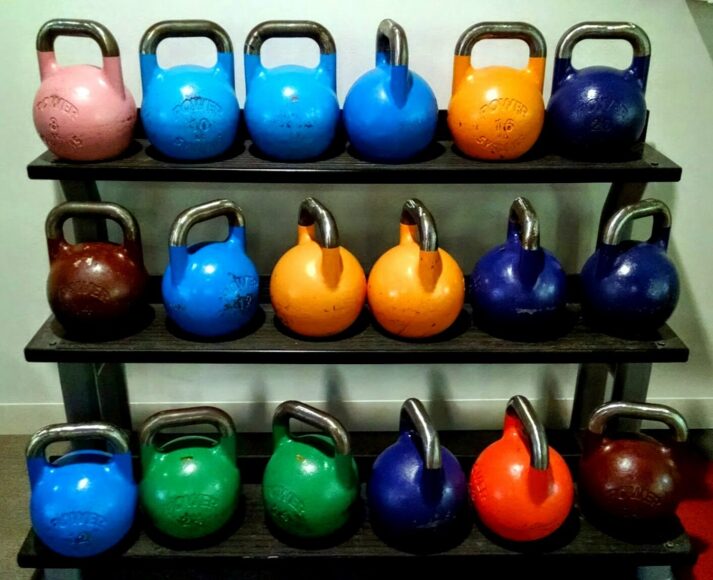
Like alternating exercises above, this is the most effective way to burn fat when exercising:
- You’re getting a cardio vascular workout by consistently moving from exercise to exercise.
- You’re exercising different muscles back to back, giving each muscle group a chance to recover, but in a condensed amount of time. Efficiency for the win!
If you’re familiar with CrossFit, many of the workouts are built on circuit principles.
This is also the most effective way to make you involuntarily swear at inanimate objects.
A circuit requires you to do one set for EVERY exercise, one after the other, without stopping. After you’ve done one set of each exercise in succession, you then repeat the process two, or three, or four more times.
I’ve written about two bodyweight circuits here on the site:
We have 15 other FREE circuits you can follow to get your feet wet with building your own routine.
You can get them over on our big Circuit Training roundup guide!
Keep Track Of Everything!
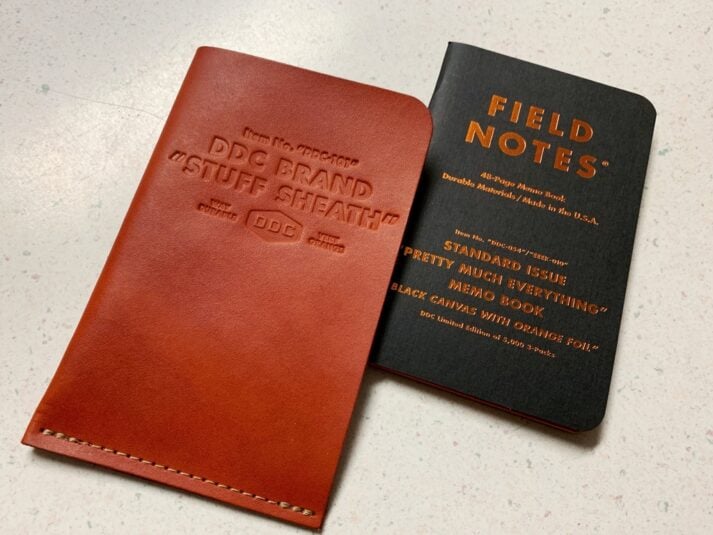
Keep a workout journal!
As they say, that which gets measured gets improved.
You should be getting stronger, faster, or more fit with each day of exercise.
Maybe you can lift more weight, lift the same amount of weight more times than before, or you can finish the same routine faster than before.
I track all of my workouts in Evernote: I note the sets, reps, weight, and date. I have over 1,000 workouts in my folder, which makes it super simple to see what I did last month, last year, and to make sure I’m improving!
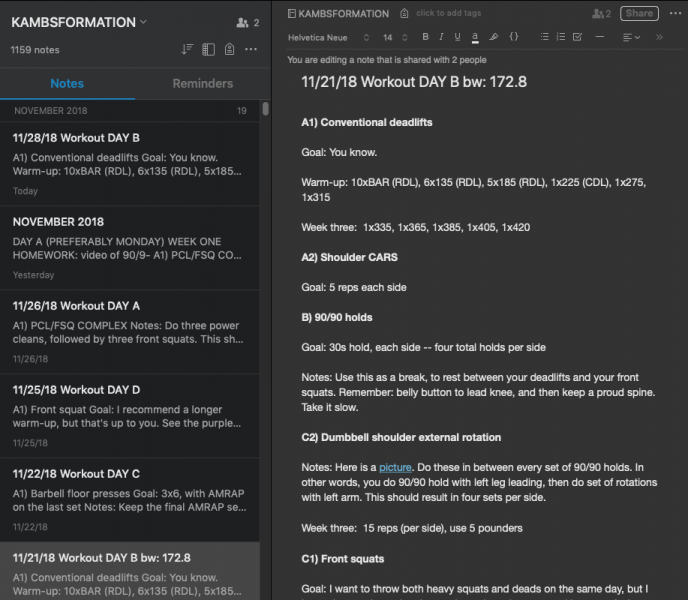
You can use an actual notebook, a bullet journal, an excel spreadsheet, a workout app, or a word document.
Don’t overcomplicate it:
- Write down the date and your sets, reps, and weight for each exercise.
- Compare yourself to your previous workout with those exercises.
- Focus on getting stronger (more reps, heavier weight, an additional set, etc.)
- Repeat.
Do this with a workout you’ve built, and you WILL get results. I promise.
Here’s how to properly track your progress and set a new personal best every time you train.
Recap: Building a Workout Routine
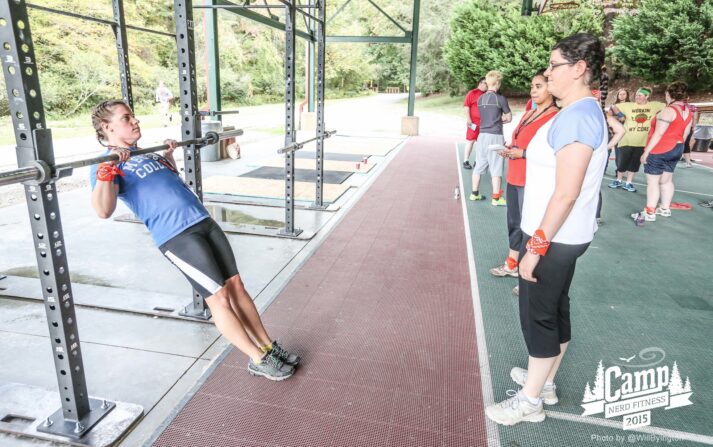
If you’re looking for sample workouts to build off of, I’d probably take the basic workouts in our “Gym 101” article.
If you want to build from scratch, great! Let’s break it down into easy chunks with this recap:
- ALWAYS warm up – 5-10 minutes on a bike, rowing machine, jumping jacks, run up and down your stairs, etc. Get the blood flowing and your muscles warm.
- Pick one exercise for each big muscle group – quads, butt and hamstrings, push, pull, and core.
- Do 3-5 sets for each exercise.
- Do 5-10 reps per set for each exercise.
- Determine how many reps and how long you’ll wait between sets for each exercise. Keep it simple. 60 seconds.
- Increase your efficiency and work your heart by doing alternating sets or circuits.
- Keep your workout to under an hour.
- Stretch AFTER your workout.
- Write everything down!
- Give yourself permission to mess up, keep learning and improving it as you train more regularly!
More often than not, when I email people back and tell them how to build their own workout, they generally respond with:
“Steve, can’t you just TELL me what to do? I’m afraid of building a crappy workout.”
If that sounds like you, check the PS below.
I certainly encourage you to try and build your own workout routine though, it can really help you develop a sense of excitement and pride when you start to get in shape based on your workout!
If you have more questions, or a workout program you’re really proud of, share it in the comments below!
Now, go do some push-ups 🙂
-Steve
PS: If you’re somebody that wants an expert to guide them through the training process, I hear ya (I have a fitness coach myself who programs my workouts!).
That’s why we built two options for people:
1) If you are somebody that wants to know they are following a program that is tailor made for their life and situation and goals, check out our popular 1-on-1 coaching program. You’ll work with our certified NF instructors who will get to know you better than you know yourself and program your workouts and nutrition for you.
2) Good at following instructions and want a blueprint to follow? Check out our self-paced online course, the Nerd Fitness Academy.
The Academy has 20+ workouts for both bodyweight or weight training, a benchmark test to determine your starting workout, HD demonstrations of every movement, boss battles so you know when you to level up your routine, meal plans, a questing system, and supportive community.
###
photo: mdwombat, joshtasman: Question Finger 6, black.zack00: Yeaaaah…. Surprise ladies!!, Sterling College: Sterling Gym, ako_law: Stopwatch, black.zack00: Boxing a gentleman’s sport, Photographing Travis: Kettlebells. ahockley: DDC Stuff Sheath and EEEK Field Notes
Filed under: Fitness


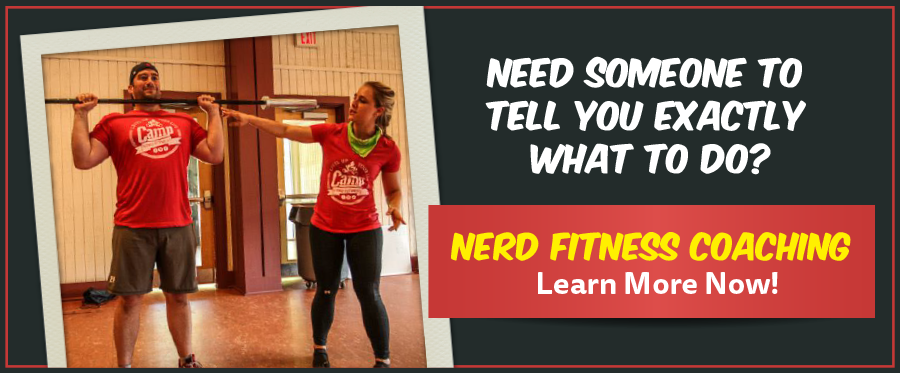
 For now classes are 6pm and 640pm at 2840 Wildwood st in the Boise Cloggers studio.
Book your class NOW!
click this ==>
For now classes are 6pm and 640pm at 2840 Wildwood st in the Boise Cloggers studio.
Book your class NOW!
click this ==>








